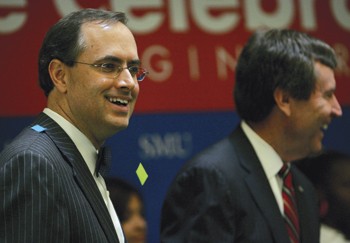
Brent Christopher (left), President and CEO of the Communities Foundation of Texas shares a smile with SMU President R. Gerald Turner (right) after the announcement of a $10.1 million gift to establish the Caruth Institute for Engineering Education and a help fund the construction of a new Caruth Hall. (John Schreiber)
In front of blinking news cameras, scribbling reporters and anxious members of the SMU community, President R. Gerald Turner officially announced a $10.1 million gift to the School of Engineering Thursday morning. The gift, from the W.W. Caruth Jr. Foundation through the nonprofit Communities Foundation of Texas, is the largest in the engineering school’s history.
“As we approach our centennial celebration, it is fitting that the Caruth name is once again linked with SMU, because the Caruth family made the original gift of land that helped to assure the university’s location in Dallas,” Turner said.
Part of the gift, $5.1 million of it, will go toward the Caruth Institute for Engineering Education. This program will not just help SMU, but also K-16 engineering education across the nation. According to information distributed at the ceremony today, less than 15 percent of U.S. high school graduates have the background to pursue a major in engineering. The newly endowed and named institute would work to change this, working with elementary and middle schools, as opposed to just high school students.
“This is the largest and most important gift to enable kids to understand what it takes to be an innovator,” Geoffrey Orsak said, the engineering school Dean.
But, as Orsak said, the institute is barely in existence without a building to house it in. The other $5 million will go toward an $18 million cutting edge, green facility, Caruth Hall.
“It will be a building where students are innovating,” Orsak said, “not just learning.”
According to Orsak, SMU will break ground on the building next summer and it will be operational by 2009. The building will change the landscape of SMU’s campus, but some engineering students wonder what it will do for them specifically.
“It makes me feel good that I’m going to a really important school,” first year Udoka Omenukor said. “I’m sure it will help kids that are still in high school and middle school, but I’m not really sure what it will do for me right now.”
Students in the Engineering School were seen throughout campus yesterday, sporting long-sleeve white T-shirts with the phrase “Compete to Win” on the front. This is the idea behind the new direction of engineering education at SMU.
“Unless we are competing, and competing to win,” Orsak said, “we are falling behind.”
Orsak emphasized the importance of the gift not only to engineering but also to the mission to increase competitiveness among United States students, and our population as a whole.
“All of us have a stake in the success of this program,” he said.
In fact, many programs are riding on the success of the Caruth Institute. It is also the home to the Infinity Project, The Gender Parity Initiative, Science Readiness Institute, Visioneering and College Partnerships.
“The resources of this gift has real potential in changing how engineering is taught,” Texas Instruments Chairman of the Board Tom Engibous said.
According to Engibous, right now students like math and science, but aren’t really sure what they can do with it in the future. And of the four million students who graduate from U.S. high schools each year, less than two percent of them will obtain a degree in engineering. The Caruth Institute will work to change this problem.
“Engineering is not just about education, but about hope,” Orsak said, “and hope for tomorrow.”








